The Everglades wetlands
The Everglades- A case study of resilience, renewal and adaptation
“The Everglades is a national experiment in sustainability science, with some successes and a history of failures. “ (Gunderson and Light 2004)

The Everglades is an internationally recognized wetland ecosystem, which was modified during the 20th century is now a highly regulated, tightly coupled social-ecological system (Figure 1). Water management has been successful at controlling and stabilizing water to meet social goals of economic and agricultural development. Indeed, millions of urban residents utilize water from the Everglades, as does a profitable agricultural community. However, the environmental and ecological indicators of the ecosystem have indicated a decline in ecosystem function and structure. Attempts are underway to restore those lost ecological attributes, while maintaining the successful development and economic achievements. The manipulation of the landscape by humans is not new, and dates back thousands of years to the emergence of a new set of ecosystems with the first arrival of humans.
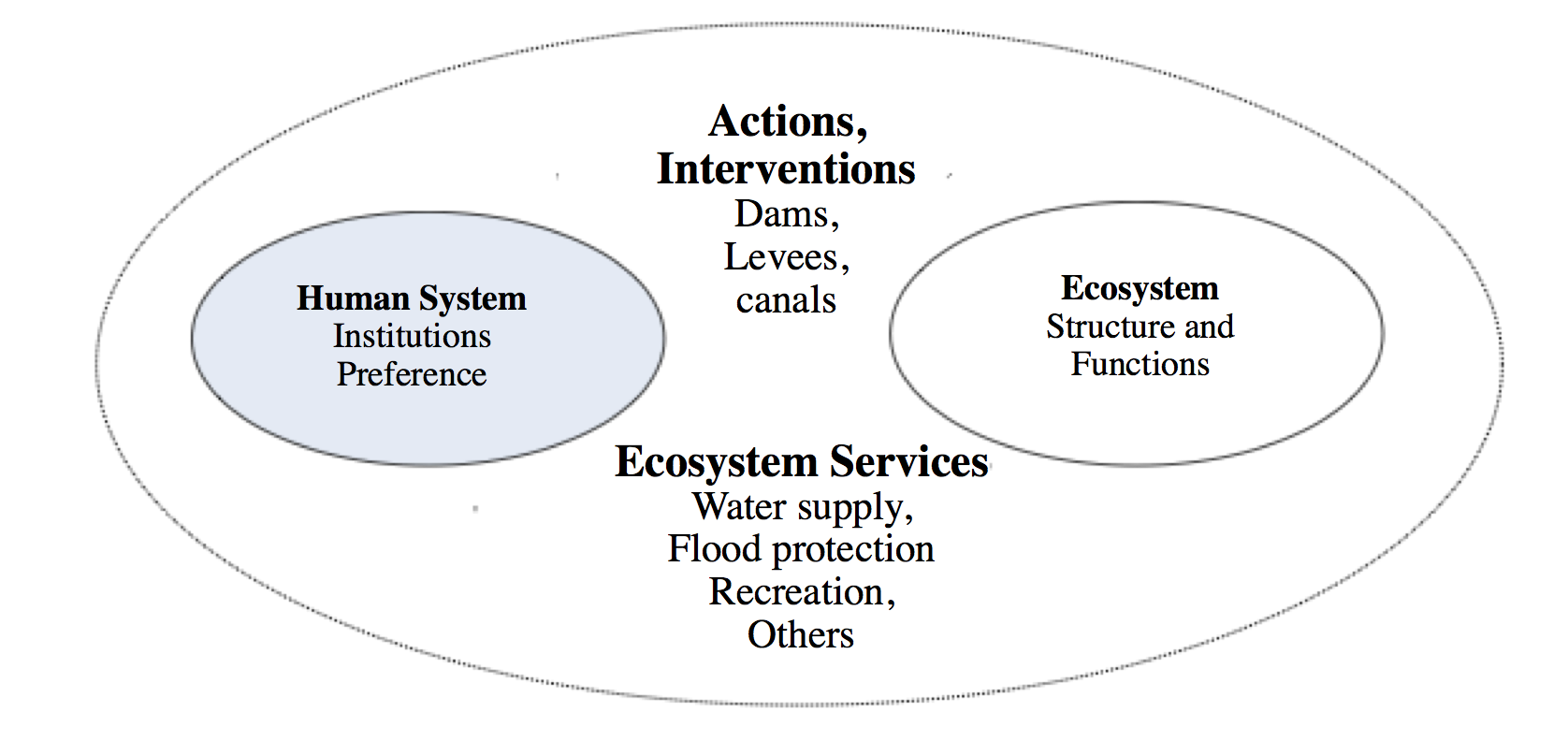
At the end of the Holocene, a changing climate brought about the current Everglades wetland ecosystem. Ten thousand years before present, the climate was cooler and dryer, sea levels were many meters lower and south Florida was covered with woody terrestrial ecosystems, rather than a vast wetland. As sea levels rose, the land area shrunk, and the current climate and wetlands of the Everglades were established. For the past several thousand years, the wetland complex has been sustained by flat topography, large rainfall inputs saturated soils for most of the year and interannual droughts, floods and cyclones. Moreover, it was an oligotrophic (nutrient poor), large system that produced diverse flora and fauna, and supported large populations of wading birds and alligators (Davis and Ogden 1995). Moreover, due to a changing climate and connections to Asia, the human diaspora resulted in people arriving about the same time as the wetland was being formed. The ecosystem and people co-existed for thousands of years, until arrival by Europeans who exerted growing demands and controls over the ecosystem, beginning in the late 19th century.
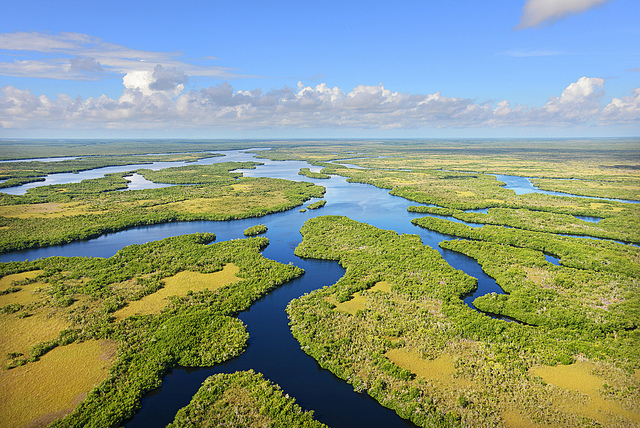
Over the past century humans increased control over hydrology and nature in south Florida. The first attempts were aimed at draining the wetlands to grow food and allow for human settlement of the Everglades. The use of land in the Everglades relied on construction of canals, levees, pumps and rules sets to control, redirect and stabilize hydrologic processes. The management system has changed the timing, magnitude and distribution of downstream flows, and caused large-scale changes in the ecology, altering biological productivity and energy flow.
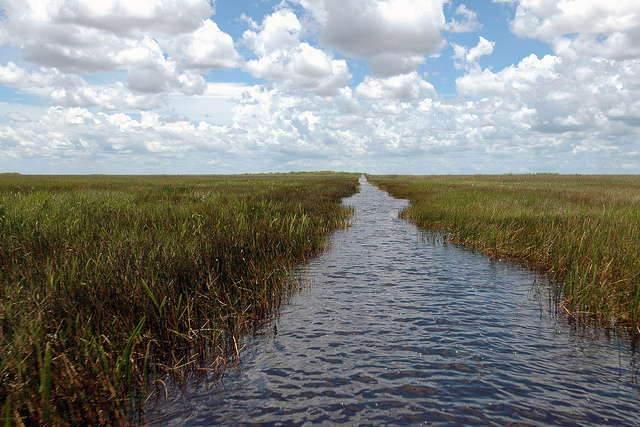
The evolution of the water resource management system was not a linear pattern of planned development, but rather an abrupt pattern of crisis, response and adaption as well as evolution over time (Gunderson and Holling 2002). The development was marked by ecological surprises, in which the system behaved in ways that were unforeseen and unpredicted. Some of these surprises signaled by ecological regime shifts, signaling an erosion of resilience (Holling, 1973, Folke et al. 2004, Walker and Salt, 2008). Such abrupt transformations occur as a result of at least three simplistic pathways, as described below.
Human technology alters key biophysical processes that lead to a direct ecological or social regime shift Infrequent, large-scale events such as (storms or extreme precipitation) overwhelm the system’s capacity to control or contain or manage the event that can lead to ecological and social transformations Human management to stabilize key ecosystem processes leads to an erosion of ecological resilience that in turn alters ecological and social regimes
Such patterns can be described in the history of many natural resource systems (Gunderson et al. 1995, Folke et al., 2004). The unfolding of these patterns is described in more detail in the following sections.
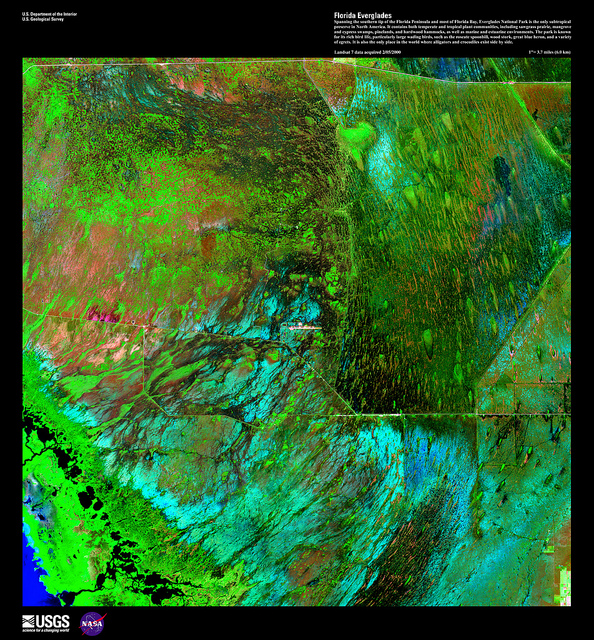
A History of Adaptation and Transformation
Throughout the 20th century, the collective actions of society have been successful at commanding and controlling the water resources of southern Florida to meet specific societal goals. Those goals included a) preventing floods, b) draining excess water, c) supplying water during droughts and d) maintaining clean water. This was accomplished by constructing and operating a massive water-control system of levees, canals, pumps, spillways, other structures, and adopting a complex set of operating rules that are implemented by governmental agencies at the local, state and federal level (Light et al., 1995). That system of water control has enabled dramatic development of urban and economic development along the southeastern coast. In 2000, about 8 million people resided in the watershed and depended upon this large system for water supply and flood control. Yet other sectors exist, including a viable agricultural community, biosphere reserve and conservation areas.
The allocation of water among urban, agricultural and environmental sectors has a rich and disputed history as a water management system itself. Light et al. (1995) were the first to show that the pattern of water management and development was not rational, linear or uniform. Rather the history depicts a pattern of environmental crisis followed by adaptation (Light et al. 1995). The crises can be sorted into three categories; 1) too much water (floods), 2) too little water (droughts) and 3) unclean water (pollution episodes).
Responses to Floods. In 1905, Napoleon Bonaparte Broward became the Governor of Florida and promised to drain the Everglades. Early on canals were dug to remove excess floodwaters. This drainage led to development, and the construction of small earthen dikes around the southern part of Lake Okeechobee to protect the growing population. These levees were breached during the hurricane of 1928, resulting in extensive flooding and a loss of about 2,400 lives (Blake 1980). In response, the U.S. Federal government funded the construction of the Herbert Hoover Dike around the lake, which was completed by 1938, in order to contain floodwaters from spreading into the nearby urban and agricultural areas. Extensive flooding returned in 1947, following an extremely wet season in which over 12 feet (3.7 meters) of rain fell on the region. In 1948, a new law was passed, which authorized a massive flood control project, with cost and management shared by the federal and state governments. The act authorized the U.S. Army Corps of Engineers to develop a plan known as the Central and Southern Florida Project for Flood Control and Other Purposes (Douglas 1947). The plan called for the protection of the east coast and agricultural areas from flooding, and to provide recharge of regional aquifers in order to prevent saltwater intrusion. In 1949, the state legislature created the Central and Southern Florida Flood Control District (FCD) to act as local sponsors for the federal project. This project locked-in land uses and water management practices that persist to date (Figure 2).
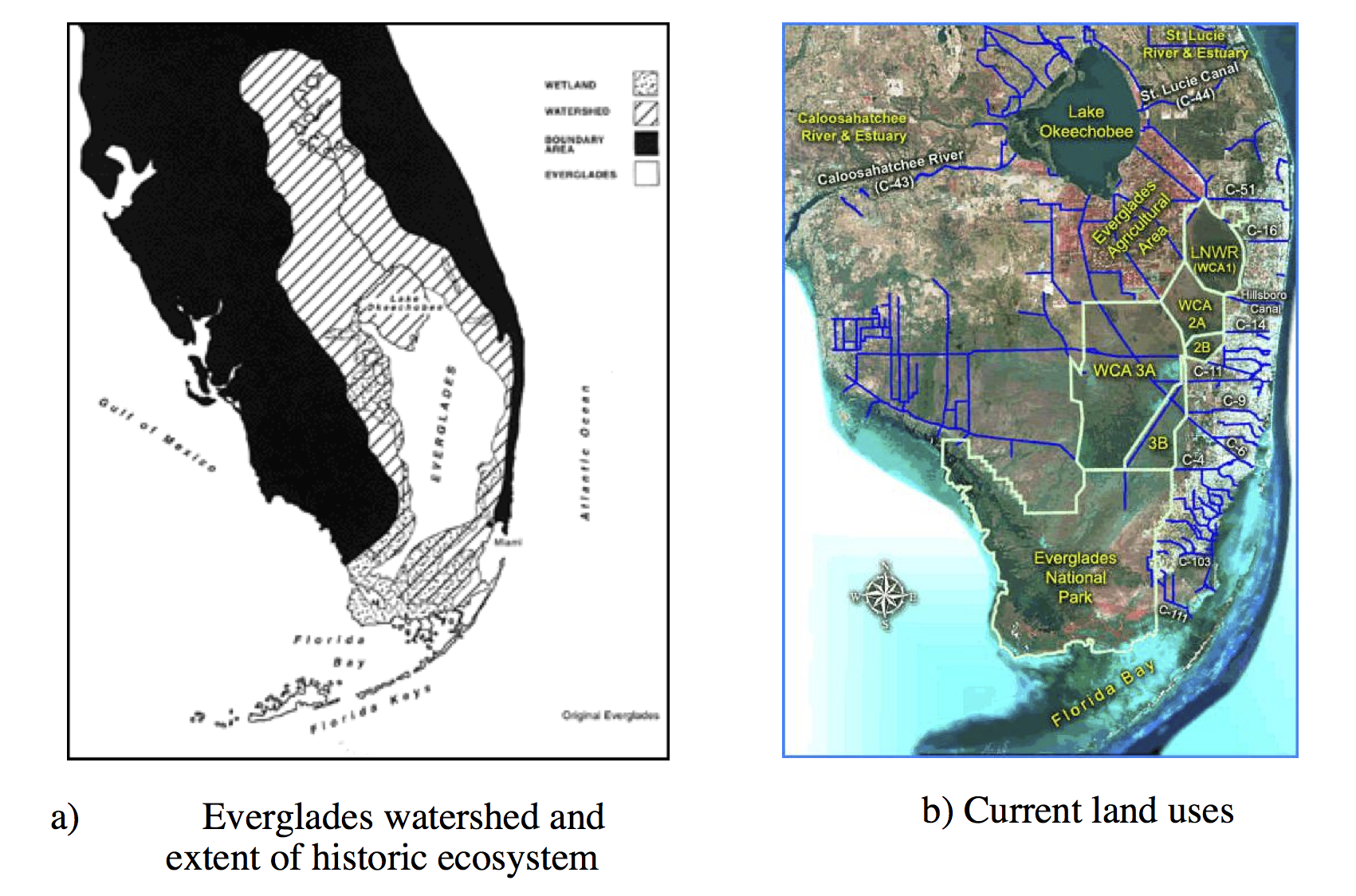
The northern third of the historic ecosystem was designated as the Everglades Agricultural area. Water is controlled through the use of canals, levees and pumps to quickly drain areas subject to flooding and supply water during dry periods, with all actions coordinated to optimize crop production. Those crops are dominated by a single plant, sugar cane, as a result of subsidies paid by the federal government to spur domestic sugar production in the early 1960’s. These supports persist to date, and shore up an economic system of farming and refineries in the area. Production of sugarcane and other crops require the use of fertilizers, which has led to water pollution issues, as will be described below.
Two areas of the Everglades are set aside for preservation. At the southern end of the Everglades, about one/fifth of the historic wetland was designated as Everglades National Park in 1948. This is part of the US National park system, with a stated purpose is “to conserve the scenery and the natural and historic objects and the wildlife therein and to provide for the enjoyment of the same in such manner and by such means as will leave them unimpaired for the enjoyment of future generations”. Everglades National Park is also an International Biosphere Reserve and a Ramsar Wetland. Just north of the park, large areas were designated as water conservation areas (Figure 2). These were designated to provide water to the park, as well as recreational and other benefits to a public whose tax dollars were used to construct the massive flood control project.
The large-scale program took over a decade to build, and just as the project was completed, a new surprise occurred. But this time, rather than too much water, the system had to confront problems from too little rainfall.
Responses to Droughts. In 1962 a drought prompted federal scientists to develop a formula for delivering water to Everglades National Park. This led to federal law that created a formula for water delivery to the park, which sits at the downstream position of the watershed. Subsequent drought periods in the late 1960s and early 1970s led to sweeping reforms in state legislation to assure a clean water supply for rapidly growing urban populations on the eastern border of the Everglades. The state of Florida created a new institution; called a water management district that was based on hydrologic boundaries. A nine-member board governs each district, with each member appointed by the Governor of the state of Florida. The districts have authority over almost all aspects of freshwater, notwithstanding the estuaries and certain water quality responsibilities. They oversee four principal functions; water supply, flood control (including storm water), water quality (for resource protection) and natural systems. The districts allocate permits to municipalities for withdrawal, treatment and distribution. All withdrawals for agricultural, residential, industrial and commercial developments require permits that are managed by the districts. The district’s operations are funded by ad valorem property taxes, which have provided a stable and exceptional fiscal base for the institution. This funding model proved stable until a collapse of housing and property values occurred in 2008.
Responses to Water pollution. In the 1980’s, the degradation of water quality became a major environmental issue in south Florida. Recurring algae blooms in Lake Okeechobee were attributed to nutrient runoff from cattle farms to the north of the lake and from crop and agriculture to the south (Davis and Ogden, 1994). The water quality crisis in the lake led to a shift in policies of how water was moved across the landscape, and to management practices that limited nutrient inputs to the lake. When water could no longer be pumped from agricultural fields to the lake, it was moved south, resulting in shifts in vegetation, algae and benthic communities (Davis and Ogden, 1994). These shifts were a change in ecological regime, shifting from a native wet prairie ecosystem to one dominated by cattails and eutrophic animal communities. In 1988, a lawsuit was filed by the U.S. federal government, who sued the state of Florida for failing to enforce the state’s water quality laws and thereby damaging federal resources (John 1994). The lawsuit was settled three years later, when the state accepted responsibility for the pollution and agreed to establish wetland marshes to treat agricultural runoff and implement Best Management Practices (BMPs) on agricultural land. The lawsuit also triggered political challenges to the water management practices of the SFWMD.
Ecosystem Restoration. 1990- present.
Since 1990, a major focus of management in the Everglades has been ecosystem restoration. This effort began with a modest attempt by scientists in the system to synthesize existing information in ways to help solve chronic environmental issues, such as decline in wading bird populations, vegetation changes, changes in aquatic biota, among others (Davis and Ogden 1994). This led to a number of formal planning processes (U.S. Corps of Engineers’ Restudy of the Central and Southern Florida Flood Control Project, a state-federal task force, Governors Commission for a Sustainable South Florida), which culminated in the passage of the Everglades Restoration Act in 2000 by the US Congress. That act authorized up to $7.8 billion USD for restoration purposes.
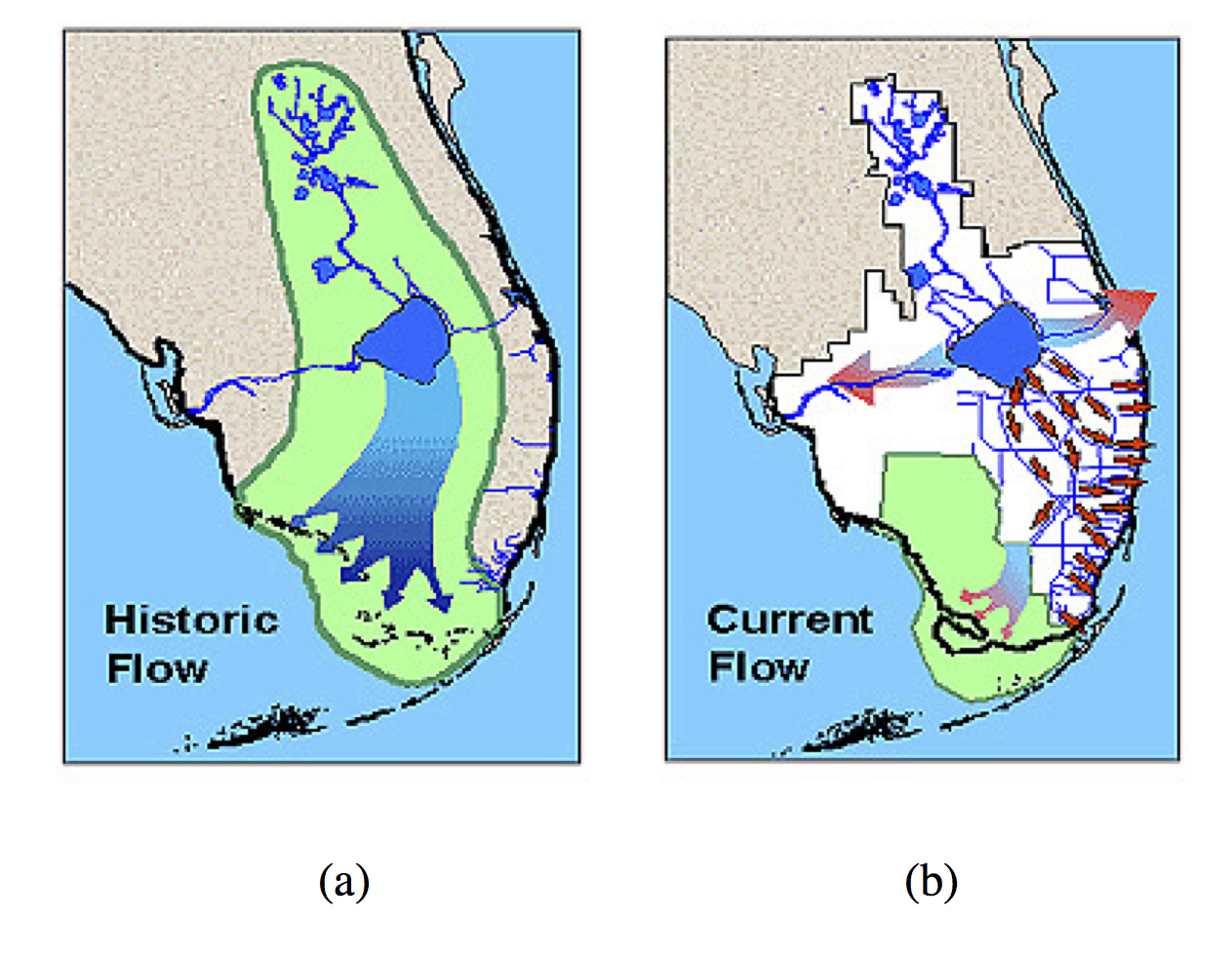
Adaptive Management and Adaptive Governance
The comprehensive Everglades Restoration Program has been underway for more than a decade. The ecological goals and programmatic objectives include: improving native plant and animal species abundance and diversity; improving habitat quality; and increasing the extent of natural areas. Other long-term goals include: increasing water storage; natural hydropatterns; improving quantity of freshwater flow through the ecosystem; and restoring degraded water quality. The federal law that created the large, complex interagency collaborative program to pursue the restoration goals authorized an adaptive management approach. The program has unfolded as a scientifically based approach rather than an active, adaptive management one. The distinction between these two is that scientific approaches assume that the effects of management actions can be known before actions are taken, whereas an adaptive approach is based on learning by doing. The ongoing recovery program has not been conducted large scale, system wide experiments, but has rather focused on identifying key ecosystem indicators and hoping that nature will provide enough variation in processes to test the restoration hypotheses. A series of adaptive management experiments have been planned, but have never been implemented due to social and institutional inflexibility and existing water management rules that are resistant to change. This is even more puzzling, as prior large projects in the Everglades, such as the Kissimmee Restoration and Everglades Nutrient Removal projects, have had adaptive management elements to them, but the benefits of an experimentation approach have not been effectively translated into system practice. Currently, Everglades management continues a focus on planning and seeking absolute certainty prior to action, rather than confronting the unknowns of such a complex and dynamic system. As such, the scientific approach persists and has proven to be resilient to adaptive learning opportunities. In short, the failure to actively and adaptively manage towards restoration goals, is due in large part to the inability to develop adaptive governance. Such governance would foster social learning, imaginative syntheses and resolve underlying social tensions that impede adaptive restoration.
Summary
Water management in the Everglades has created a tightly coupled social-ecological system. The modifications to the hydrologic system were done to control water quantity and quality within the watershed for three different land uses. Each of these land uses reflects a particular configuration and delivery of ecosystem goods and services. About one-third of the historical wetland has been set aside to preserve biodiversity, provide water, recreation and other intrinsic values. These areas are designated as national parks, and conservation areas. About one-third of the historic ecosystem has been converted to agriculture; utilizing the natural capital in the organic soils and mild climate to support year round production of sugarcane and other vegetables. The water rich, subtropical climate sets the stage for a seasonal tourism economy. The coupled social-ecological system is now operated to provide water resources for millions of inhabitants within the watershed.
The pattern of development was not planned and implemented in a linear and progressive manner. Rather it represents a model resource use and development where unforeseen ecological dynamics precipitate a series of environmental crises, which signals an undeniable failure of past policies and practices. Each crisis, as indicated in Table 1, leads to new policies and programs that attempt to achieve a shifting set of new social goals. Over time, these patterns reveal how management achieves narrow economic and social goals leading to an erosion of ecological resilience. The loss of resilience is manifested by regime changes in both the social and ecological components of the coupled system. Current efforts to facilitate a regime shift towards a more desired and sustainable Everglades ecosystem for the use by future generations are hampered by institutions that are in perpetual conflict, supported by politics and entrenched powers. Yet much is at stake to resolve these issues. In the words of Marjorie Stoneman Douglas, the grand dame of conservation; “the Everglades is a test…. If we pass, we get to keep the planet”.
Contributors
Lance Gunderson, Dept. of Environmental Sciences, Emory University, Atlanta, GA, USA, Jon Norberg
References
Blake, N. M. (1980). Land into Water-Water into Land: A History of Water Management in Florida. Tallahassee, Florida, University Presses of Florida. Davis, S. M. and J. C. Ogden, Eds. (1994). Everglades: The Ecosystem and Its Restoration. Deerfield Beach, FL, St. Lucie Press.
Douglas, M. S. (1947). The Everglades: River of Grass. New York, Rinehart & Company.
Folke, C., S. Carpenter, B. Walker, M. Scheffer, T. Elmqvist, L. Gunderson and C. S. Holling (2004). “Regime shifts, resilience, and biodiversity in ecosystem management.” Annual Review of Ecology Evolution and Systematics 35: 557-581.
Gunderson, L., C. Holling and S. Light (1995). Barriers and Bridges to the Renewal of Ecosystems and Institutions. New York, Columbia University Press.
Gunderson, L. H. and C. S. Holling, Eds. (2002). Panarchy: Understanding Transformations in Systems of Humans and Nature. Washington DC, Island Press.
Gunderson, L. and S.S.Light (2006 ). “Adaptive management and adaptive governance in the everglades ecosystem. .” Policy Sci 39: 323–334.
Holling, C. S. (1973). “Resilience and stability of ecological systems.” Annual Review of Ecology and Systematics 4: 1-23.
John, D. (1994). Civic Environmentalism: Alternatives to Regulation in States and Communities. Washington D.C., U.S.A., CQ Press
Light, S. S., L. H. Gunderson and C. S. Holling (1995). The Everglades: Evolution of Management in a Turbulent Ecosystem. Barriers and Bridges to the Renewal of Ecosysyems and Institutions. L. H. Gunderson, C. S. Holling and S. S. Light. New York, Columbia University Press: 103-168.
Walker, B. and D. Salt (2006). Resilience Thinking: Sustaining Ecosystems and People in a Changing World, Island Press.
Leave a Comment